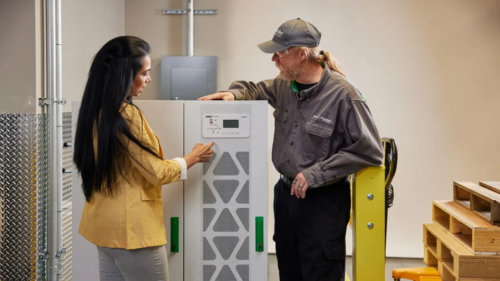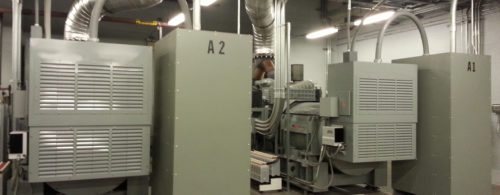Selecting and sizing transformers in nonresidential buildings
Transformers are an essential component of almost any electrical distribution system. Design engineers should know the design concepts, the codes and standards for selecting and sizing transformers to ensure they are appropriate for the application
Learning Objectives
- Learn the basics of selecting and sizing transformers.
- Understand the impact of load types on transformers design.
- Know the codes that pertain to sizing and design of transformers.
When designing an electrical distribution system, design engineers must ensure that transformers and the electrical distribution systems that they support are appropriate for the application. There are many questions that must be addressed before selecting and sizing transformers. Most of these questions are related to the type of application and the site operating conditions, which drives selection of the different components of the transformers and their characteristics.
The answers to these questions will help design engineers in making decisions regarding sizing, type, loading, configuration and whether the transformers should be installed outdoor or indoor, vault or cage and many other criteria.
Codes and regulations
The applicable codes and regulations set the parameters for the design, performance and maintenance requirements. The sizing and selection of transformers will determine which set of codes and regulations apply to the design. The NFPA 70-2017: National Electrical Code, Department of Energy efficiency requirements and Environmental Protection Agency containment requirements cover the essential aspects of those requirements. The design engineer must carefully consider all the different codes and regulations that will apply to the transformer selection and sizing.
NFPA 70-2017: National Electrical Code provides the key design requirements for transformers. These design requirements are found mainly in NEC Article 450: transformers and transformer vaults (including secondary ties). Additional requirements, depending on the application, are found in NEC Article 440: air conditioning and refrigerating equipment; Article 610: cranes and hoists; Article 620: elevators, dumbwaiters, escalators, moving walks, platform lifts and stairway chairlifts; and Article 695: fire pumps.
Department of Energy efficiency standards for distribution transformers, which went into effect Jan. 1, 2016, 10 CFR Part 431 Energy Conservation Program: Energy Conservation Standards for Distribution Transformers, outlines the efficiency requirements according to the transformer type (liquid versus dry-type distribution transformers), single-phase or three-phase transformers and ampere rating.
Environmental Protection Agency – 40 CFR Part 112 Oil Pollution Prevention defines the secondary containment requirements for oil-filled operational equipment, such as oil-filled transformers. It is often a unique challenge to meet the requirement for providing permanent containment structures, which may not be achievable.
As an alternative, owners and operators of facilities with oil-filled operational equipment have the option to prepare an oil spill contingency plan and a written commitment of manpower, equipment and materials to expeditiously control and remove any oil discharged that may be harmful, in lieu of general secondary containment. In this case, the owners or operators may use the flexibility of active containment measures. However, active containment measures may be risky because they require the ability to detect a discharge and these measures must be implemented effectively and in a timely manner.
Additional codes and regulations apply in some special applications, such as fire pumps. NFPA 20: Installation of Stationary Pumps for Fire Protection and NFPA 70, Article 695: Fire Pumps, provide guidelines for transformers design. Per 695.5, where a transformer supplies an electric motor–driven fire pump, it shall be rated at a minimum of 125% of the sum of the fire pump motor(s) and pressure maintenance pump(s) motor loads and 100% of the associated fire pump accessory equipment supplied by the transformer.
Early involvement of the permitting agency and the authority having jurisdiction will help the design engineer determine which set of codes and regulations apply to the sizing and selection of transformers during design phase and help understand the different interpretations of the codes.
Transformer construction
A transformer is basically constructed of two windings (coils) electromagnetically coupled through a steel core. Both the windings and the core are electrically insulated from each other (see Figure 1). When an alternating current source is connected to one of the windings, it is defined as the primary side. The alternating current passing through the winding will generate a varying magnetic flux in the core. The change in the magnetic flux due to the passing of alternating current through the primary winding will result in inducing voltage on the secondary side winding.
If a load is connected to the secondary side winding terminals, it will close the electric circuit and an alternating current will start flowing through the winding. The voltage is directly proportional to the windings number of turns ratio and the current is inversely proportional to the windings number of turns ratio. So, a step-down transformer primary to secondary windings turns ratio will be greater than 1 while a step-up transformer primary to secondary windings turns ratio will be less than 1.
For example: If the ratio of the primary winding number of turns to the secondary winding number of turns equals 1000:100, it means that if there are 1000 volts applied to the primary winding, there will be 100 volts on the secondary winding. In this case, the transformer is defined as a step-down transformer.
The primary and secondary voltages for commercially available transformers are 2,400; 4,160; 7,200; 12,470 and 13,200 for 15-kilovolt class and 120, 208, 240, 277 and 480 for 600–volt class.
Other factors that should be considered in selecting transformers, other than voltage ratings for both primary and secondary, are voltage taps, efficiency, impedance value, types of cooling and temperature rise, voltage insulation class, basic impulse level and sound level (see Figures 2 and 3).
Transformer losses
The transformer is comprised of components that greatly affect the performance of the transformer. The common key components to consider when selecting a transformer are the winding and the core. The transformer is a static AC machine with no losses attributed to friction from rotating parts. However, there are two components that significantly contributes to transformer losses: Core losses known as no-load losses and winding losses known as load losses.
The core losses are generated in the steel core of the transformer by the excitation current. The excitation current is defined as the magnetizing current needed to energize the core. The core losses are categorized into three components hysteresis losses, flux leakage and eddy currents.
The biggest contributor to no-load losses is hysteresis losses. Hysteresis losses are introduced each time the magnetic field is reversed, a small amount of energy is lost to hysteresis in the magnetic core and when nonlinear application of the voltage applied in the transformer core. The hysteresis loss can be reduced by implementing material having smallest area of hysteresis loop. Generally, silicon steel is used, which is having least hysteresis loop area.
The flux leakage, also known as stray losses, is the magnetic flux induced by the transformer primary winding and does not pass through the core to the transformer secondary winding. A portion of the leakage flux may also induce eddy currents within nearby conductive objects, such as the transformer support structure and be converted to heat. The recognizable humming or buzzing noise noticed near transformers is a result of stray fields causing components of the transformer to vibrate and is also from magnetostriction vibration of the core. A shell-type core is used to reduce flux leakage.
The eddy currents are induced by the varying magnetic flux in the core, which causes flow of circulating currents in the core. The heat loss taking place due to these circulating currents is called eddy current loss. This can be reduced by manufacturing core in form of stack of lamination.
The core losses are called the transformer constant losses because they do not change with transformer loading, however, they will change with the size of the transformer and steel core construction. Core losses will continue to consume energy even if the transformer remains energized at no-load.
The winding losses are generated by the current passing in the primary and secondary windings of the transformer and are a result of the resistance from the windings material. The winding losses increase with transformer loading. Only change to the resistance of the winding can reduce winding losses because the current portion of the winding losses cannot change, which are determined by the load requirements. Reduction in winding losses is achieved by using a material that has a low resistance per cross-sectional area without adding significantly to the cost of the transformer.
Copper is the best conductor considering weight, size, cost and resistance of the conductor. Aluminum is also used, however the cross-sectional area of the conductor is increased to reduce the resistance of the conductor, which will cause the overall transformer dimensions and increase the footprint. If real estate cost is not a driving factor then, aluminum would be most economical.
Site operating conditions
The location of the transformer to be installed will have substantial impact on how the transformer is built and what accessories should be included. If the transformer is to be installed indoors in a designated room or co-located with other building system equipment, a ventilated dry-type transformer configuration can be used. However other concerns arise.
Transformers must be accessible for operation and maintenance. Building load–bearing capacity must be adequate to support the transformers. Construction must comply with applicable codes and regulations (noise, heat losses, vibration) and room layout must satisfy manufacturer requirements for adequate ventilation and clearances around transformers.
In many cases, if the transformer is small enough, typically 75 kilovolt-amperes or less, it can be ceiling mounted. However, only dry-type transformers not exceeding 50 kilovolt-amperes are permitted per NEC to be installed in the hollow space above removable ceiling otherwise removable ceiling will need to be permanently removed. A structural engineer needs to be engaged early in the transformer selection and design process to evaluate the building structure load bearing capacity and determine what type of structural supports are required. Also, a mechanical engineer needs to adequately provide the ventilation or cooling required for the transformer heat removal in the heating, ventilation and air conditioning system design.
If the transformer is installed outdoors, the transformer must have a weatherproof enclosure for protection from rain, snow, corrosion and flooding. The enclosure may need to be sealed if installed in a hazardous environment to protect the transformer components from corrosive fumes or liquids.
Additional features may need to be specified when selecting the transformer, such as cooling for normal operation or increased transformer capacity. For dry-type and oil-filled transformers, it can have multiple kilovolt-amperes output ratings by adding multistage cooling fans. The design engineer must specify the cooling feature as ambient air, forced air or oil–natural air–natural (see Figures 2 and 3).
If an oil-filled transformer is selected, depending on the location and oil capacity, a secondary containment may be required (see Figure 4).
The transformer can also be equipped with tap changer, Bay-O-Net fuses, load break switch, loop feed terminal bushings and parking stands (see Figure 5).
Load characteristics
The load types and electrical characteristics to be served by the transformer have a significant impact on sizing and selection of the transformer. The design engineer must understand the load profile and assess the different design options to provide a properly sized and economical transformer of a rating based on load profile and run time requirements.
Load types are linear and nonlinear. Linear loads include heaters, motors and transformers. Nonlinear loads include computers, uninterruptable power supplies, electronic lighting ballasts, electronic equipment and variable frequency drives.
Nonlinear loads typically introduce harmonics in the electrical system. The harmonics generate additional losses and heating of the transformer coils, which reduce the transformer life expectancy. Depending on the magnitude of harmonics, total harmonic distortion present in the electrical system, the transformer can be selected with a K rating, which allows the transformer to withstand nonlinear load conditions in the electrical system. K-rated transformers do not mitigate or eliminate harmonics. However, they do protect the transformer itself from damage caused by harmonics. Linear loads such as large motor loads have high starting current (locked rotor current) that require the transformer to be oversized in some cases to overcome the heat rise caused by the high starting current.
Sizing
The design engineers, as a first step, will need to calculate the design load per NEC for each connected load application such as electric heating, air conditioning, motors, lighting, receptacles and special loads (X-ray machine or wilding machine). The next step will be determining the maximum running load (known as coincident load), which is the highest load demand anticipated at any given time. The last step adds capacity for future loads, typically 20%.
For example:
Maximum coincident load = 84 kilovolt-amperes
Spare capacity at 20% = 84 X 0.2 = 16.8 kilovolt-amperes
Total design load = 100.8 kilovolt-amperes
The minimum transformer required size is 100.8 kilovolt-amperes, however, it is not a standard size transformer that is commercially available. Therefore, a 112.5 kilovolt-amperes transformer is selected.
Parallel operation
If commercially available capacity transformer sizes cannot meet the transformer load requirement or due to lack of space, transformers can be operated in parallel. For example, if the required dry-type transformer size is 1,500 kilovolt-amperes with 480-volt primary voltage and 208-volt secondary voltage, which is not commercially available. Two 750kilovolt-amperes dry-type transformers can be operated in parallel to provide the required 1500 kilovolt amperes.
If transformers are selected to operate in parallel, the transformers must be switched as a unit to prevent dangerous feedback situation. Additionally, design engineers must ensure that applicable codes and regulations requirements are addressed such as NEC Article 450.7.
Various conditions that must be satisfied for the successful parallel operation of transformers:
- Same phase angle shift (vector group is same).
- Same frequency rating.
- Same polarity.
- Same phase sequence.
- Same voltage and turns ratio (both primary and secondary voltage rating is same).
- Same percentage impedance and X/R ratio.
- Identical position of tap changer.
- Same kilovolt-amperes ratings.
Same phase angle shift, same polarity, same phase sequence and same frequency are required for paralleled operation to be possible otherwise catastrophic damage may occur as a result of short circuit between phases or extreme circulating current.
Same voltage ratio and turns ratio, same percentage impedance, same kilovolt-amperes rating, same position of tap changer are preferred to achieve optimal performance when transformers are run in parallel by minimizing the circulating current.
Do you have experience and expertise with the topics mentioned in this content? You should consider contributing to our CFE Media editorial team and getting the recognition you and your company deserve. Click here to start this process.




